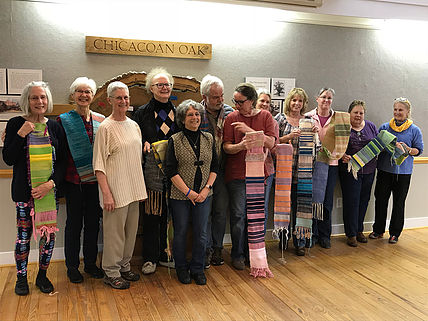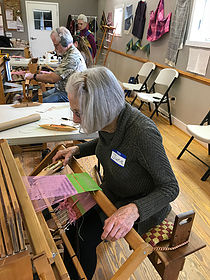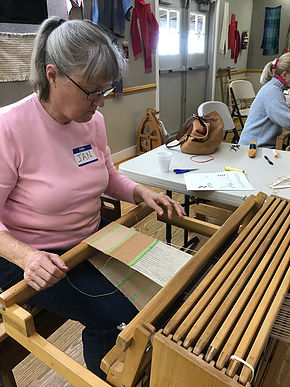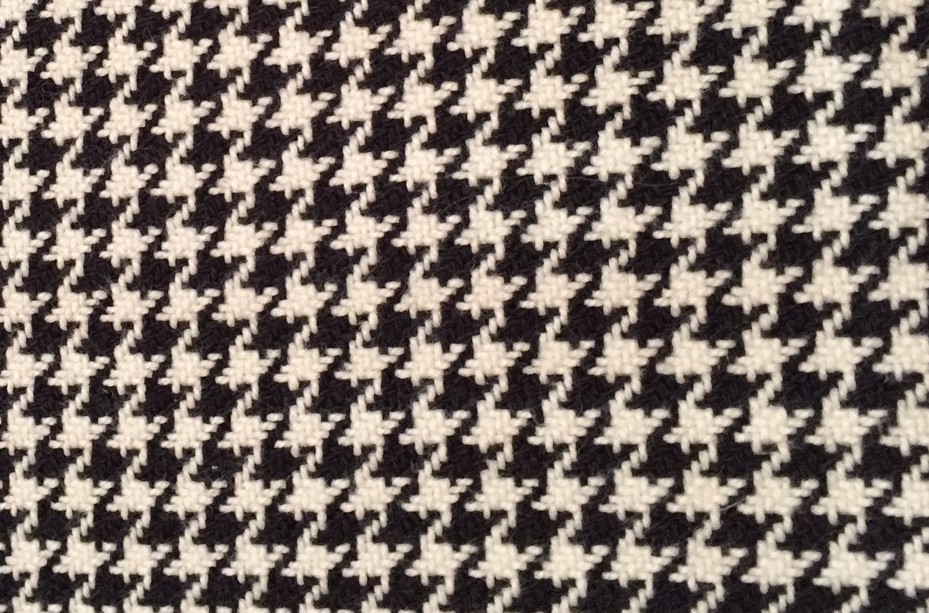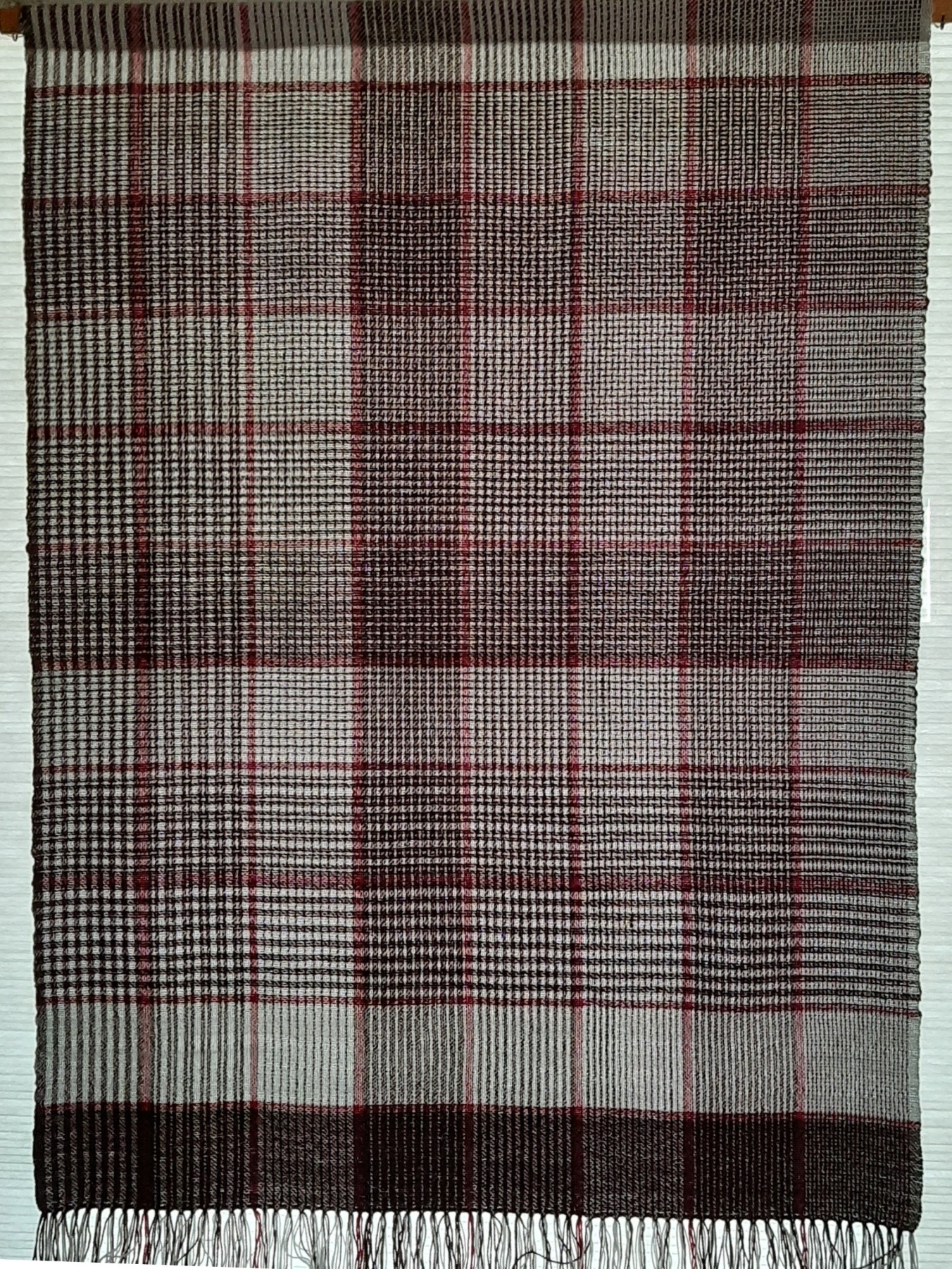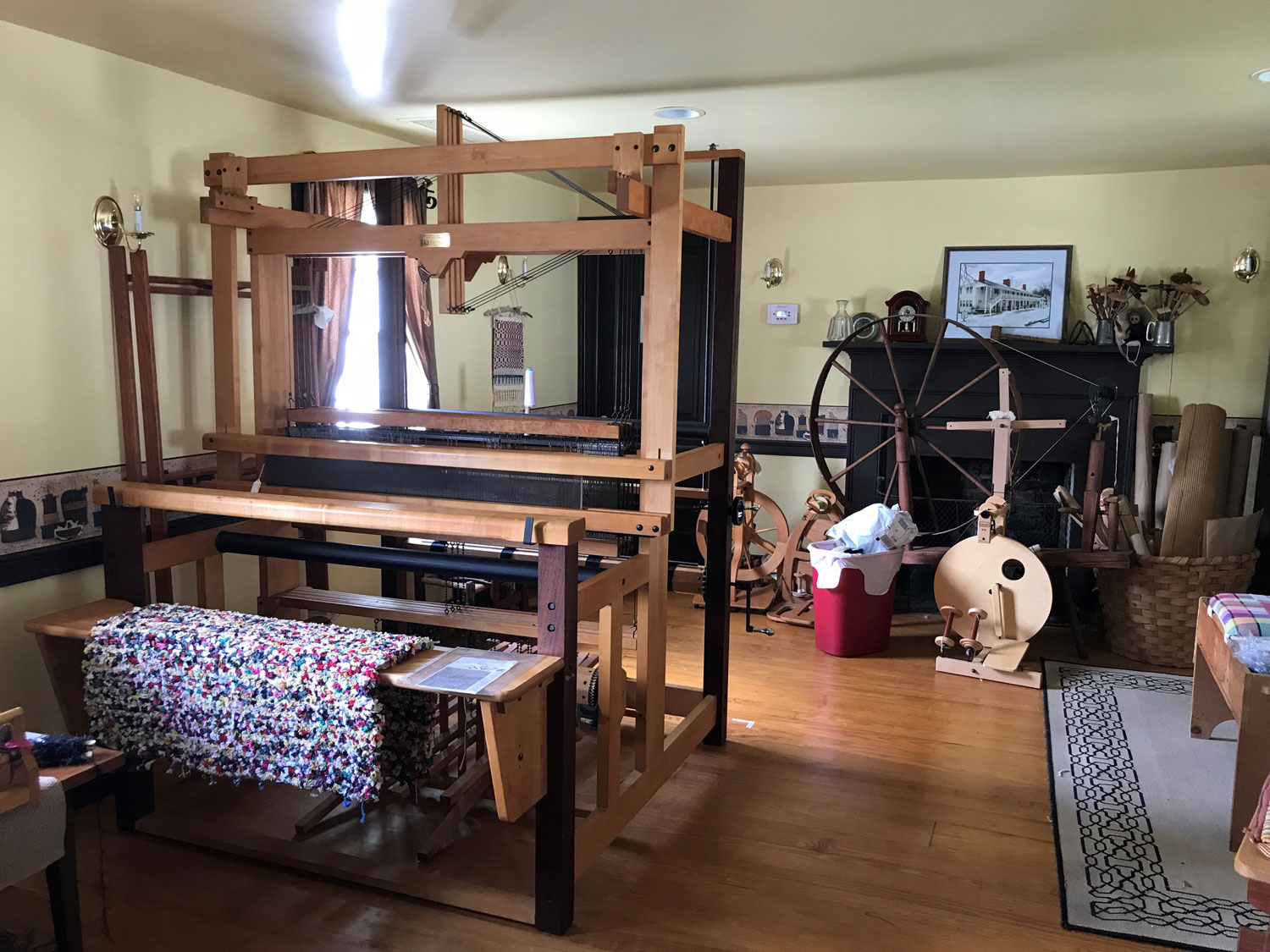
Guild President’s Corner for November
Let’s talk briefly about cotton. For the TSWG, it is certainly our most commonly-used fiber, primarily for our popular dish towels, as well as placemats and other household items. Cotton has been grown in many parts of the world, Old World and New World, at least since 500 BCE. It made a very practical and desirable textile, but it was an extremely labor-intensive fiber to grow and use. While textiles were the fuel of the Industrial Revolution, the focus was primarily on wool, as it was so readily available in England, which was the center of innovation at that time. Cotton was imported from India, but it was on a fairly small scale.
But that all changed in 1793, when Eli Whitney invented and patented the cotton gin. Until then, cotton fibers had to be separated from the seeds by hand; one worker could separate about 1 pound of cotton in a day. With the early mechanized cotton gins, that amount soared to 50 pounds in a day. Combined with the development of a cotton variety that would prosper in the American south, the cotton industry was revolutionized.
Unfortunately, the growth and harvesting of cotton was still labor-intensive, and the American south relied on the labor of enslaved people to fuel the revolution. Planters massively expanded their cultivation of cotton, the plantation system expanded, cities developed along the southern coast, and the south became entrenched in an agricultural economy. Britain’s economy (and world domination) boomed from the textile industry, and eventually the American Civil War forever altered the course of our history. So, remember that date: 1793. Remember it, and its impact, every time you warp a loom with that lovely fiber. ~ Jan
Guild President’s Corner- August
I am currently reading a fascinating book called The Fabric of Civilization (How Textiles Made the World), by Virginia Postrel. (The content is fascinating; the reading is a little laborious — much more to come about the content in later posts.) As she begins the chapter on weaving, she talks about the relationship between weaving and math, claiming “It’s ALL MATH!” Gaaaa!! What?? I love weaving, but I’m certainly not too fond of math. Actually, it’s arithmetic I’m not very good at — I did fine in school with higher mathematics. Well, I know that we have to do some arithmetic with every project we plan (and I usually make at least one mistake with every project), but the author goes on to say that “weaving is profoundly mathematical…woven cloth represents some of humanity’s earliest algorithms. It is embodied code…the existence of cloth is evidence of mathematics at work in the tangible world.” Huh. But when you think about it, weaving IS all about patterns, structures, ratios, measurements, multiplications, geometry, etc. Okay, I guess I can accept that. Just like dyeing is all about chemistry, turns out weaving is all about math. And here I thought it was all ART!! But I guess if you think about it, math has a lot of art in it also, so turnabout is fair play, right?
We had a productive meeting at the end of last month, and a great Beginning Weaving class this past weekend. Ten students, including a husband/wife combo, and a precocious 12 year-old, made quick work of winding warp, dressing their looms, and weaving right through all the various patterns we challenged them with. Many thanks to the guild members who helped out throughout the three days, and a special thanks to Jim McKenna and Tom Gauthier for their physical exertions hauling the looms back and forth in the broiling August heat. Coming up next — Summer/Winter class with Laurie Duxbury (for us) October 7-9. ~ Jan
Guild President’s Corner- July
As I file away the patterns that I cut out of the latest Handwoven magazine, and as I download two patterns that I recently purchased from Webs and Halcyon, AND as I contemplate buying the beautiful pattern from Webs that Judy recently wove, AND as I think I’d really like to weave a few of the patterns from Show and Tell, I pause for (just) a moment and ask myself, “Self, just WHEN do you think you’re actually going to weave all those things???” So I stop for just a second and ponder … and then say, “but they’re so PRETTY!!” Does this sound familiar? Of course it does! Not just with weaving, but with all the lovely fleece that we’d love to spin just because it’s so nice, or the knitting patterns that would be a PERFECT fit for that yarn that we picked up at that cute little store when we were on vacation … Between patterns, colors and items (towels, scarves, wearables), from all the books, websites, and historical archives, there is infinite variety to choose from, enough to last several lifetimes. So how DO we choose? Well, some of us are trying (forever) to use up what we have in our stash before moving on to the really good stuff. Some of the more determined of us buy yarn for a particular project and proceed straightaway to make it. Others may thumb through books or other sources looking for inspiration. Some just thread their loom and start to play. And then some of us have long lists of projects that we want to make “someday,” and gradually work our way through them, with lots
of detours as the fancy strikes us. What kind of weaver are you?
Our last meeting was a lively, well-attended affair! Of particular note, in my opinion, were the amazing letters we had received from the local art teachers, talking about what they are doing in their classes, and what they could do with a small donation from our Guild. We were blown away! As Kathy said, “Teachers rock!” I think we were all very happy to see our former Scholarship fund get diverted to the local art departments, and hoping that we can begin building a relationship with them. And second were the samples we gathered from the collaboration between our guild members and the Williamsburg guild, weaving 22 samples of 27 patterns from the Josephine Estes Miniature Overshot collection. It was amazing! And now we’re ready to complete the entire collection, so stand by! All the samples and their
corresponding patterns will be collected in a binder for the guild’s permanent collection. This was a fun and very instructive project for those who participated; a chance to learn and explore the overshot technique without a huge commitment of yarn. Overshot is neither easy nor fast, but the patterns are gorgeous. Some of us got hooked, while some of us said “Never again!!” But now we know! ~ Jan
Calling All Beginning Weavers
Since my husband has a wonderful hobby that takes him away from home for hours at a time, I decided that I also needed to find a hobby to occupy my time. My hobby needed to be a creative one as I like to work with my hands. When a weaving class was offered, I decided I should go ahead and dip my toe in the water and see how it felt. I signed up for the three day class at The Tavern (Rice Hotel/Hughlett’s Tavern) in Heathsville, VA.
Day one started out with terminology since weaving has its own language. Then it was on to winding threads onto a warping board so I could have a 3 yard length of threads that I would use to learn to weave, make a woven sampler and find out if this was the hobby for me. By the end of day one I was exhausted from all the brain work (a very good thing for a retired person) and I went home and took a nap.
At the start of day two, I was not sure this was the hobby for me, but I wasn’t going to quit as I paid my money and wanted to get my monies worth of classes. By the end of day two which was spent following clear written instructions and getting one on one help from experienced weavers who were available at the raise of a hand, I was starting to get it and was enjoying the weaving process and the visual results of making cloth. Exciting!!
Day three came and went quickly as I realized this hobby was for me. Since I knew there was so much more to learn, I mentioned to one of the lead instructors that I wanted to continue learning, but I did not have a floor loom at home like many in the class did. I was told that since I had joined the Tavern Spinners and Weavers Guild when I signed up for the class, I could start coming to the guild’s studio, The Yellow Cat Room, at the Tavern on Wednesdays and Saturdays. On these two days there are always experienced weavers in the studio to help you continue your education in weaving and learn to move forward on your own.
Now, three years later, if you visit the Yellow Cat Room and I am there, I can explain to you how a project gets started, and (once the pandemic is over) sit you down at a loom and teach you to weave. So, don’t be shy, plan on signing up at the Tavern in Heathsville, VA for a class and learn to weave.
Melinda K. Floom March 2021
Thanks to Jan for a great presentation on Tartans!
Nov. 4, 2020- TSWG members continue to impress us with their passion for weaving and their desire to learn new weave structures and techniques. At our November meeting, Jan L. treated us to a presentation on Tartans. Her interest was first piqued by a desire to create a gift for her son-in-law using his family’s traditional County Armagh tartan. Through her presentation, our members learned much about the history of tartans and some tips for successfully weaving them. Many members remarked how little they previously knew and how much they now understand about this beautiful weave structure. See her presentation notes here.
Fun with Color-and-Weave
At our March guild meeting, Sandi made a presentation on the technique of Color-and-Weave. What is that? Well, you’ve probably already woven it, whether you realized it or not. This technique typically uses two shuttles and two contrasting colors, usually a light and a dark. It could be as simple as alternating light and dark, alternating two light and two dark, etc, or it could be differing repeats of each, for example, one light and three dark. Your weave structure would usually be either plain weave or twill. Some well-known color-and-weave patterns are Log Cabin, houndstooth, and shadow weave.
Often the sequence is the same in the warp and the weft. However, Sandi was generous enough to weave a pattern-gamp (sampler) for us which shows how each of the different threading patterns changes with alternate treadlings. A few contrasting red threads separate the different sequences. Using plain weave and a black and white warp and weft clearly shows the variety of interesting patterns possible with this simple technique. You’ll find Sandi’s gamp hanging up in the studio. You can find a detailed explanation and directions here.
Grandparents Camp 2020 was a success!
July 9, 2020- Each year, Rice’s Hotel / Hughlett’s Tavern hosts a camp where participating grandparents can each bring one grandchild to experience activities with some of our resident guilds. This year, campers spent one day each with the Crafters’ Guild, the Quilt Guild, the Woodworkers’ Guild and the Tavern Spinners and Weavers. Because we are still practicing social distancing, it was decided that holding the TSWG group outside would be best, despite the warm day. Campers and their grandparent were able to first learn about wet felting with wool in order to make a small pouch, suitable to hold a cell phone or other treasures. Then, campers learned how to do some simple weaving using “cardboard looms.” Each camper was also able to take home enough wool yarn to rewarp their cardboard loom with colors of their choice.
One of our members also brought his spinning wheel and demonstrated how he spins raw wool, directly from the lock. A fun time was had by all, including (or especially) the grandparents! We look forward to next year when we hope to be able to move back inside and set up the campers at our floor looms, as we have in the past.
Come meet our newest loom! – Sally
On June 17th, our guild was blessed to have a beautiful 45″ Harrisville Rug loom donated to us. This loom was once owned by a remarkable woman named Sally Lloyd who was not only a gifted weaver but a generous and caring woman. Mrs. Lloyd founded the Woodmont Weavers in Arlington, VA which is now called Arlington Weaves, Etc. This organization “provides support to adults with developmental disabilities by teaching them technical and social skills and by helping to improve their self-sufficiency.” Their handwoven items can be purchased in their shop on Washington Blvd.
As well as completing commissioned pieces of woven artwork, Mrs. Lloyd also spent many years teaching weaving in the Arlington area. Sadly, she passed away suddenly in November of 2018. Her son wanted her cherished loom to go to a group which would carry on her legacy by continuing to share the love of weaving with their own community. In the Tavern Spinners and Weavers he found such a group. According to her obituary, “Sally was an open-hearted woman who was marked by her tolerance, grace, humor and kindness.” The TSWG only wishes that we could have met Sally Lloyd because we’re sure she would have fit right in with this welcoming, encouraging group of weavers.
Our plan is to begin learning about “Sally” by weaving what is most familiar to us, tea towels. From there, we hope to include other handwoven items such as rugs, table runners, etc. This heavy-duty loom also came with a removeable Shaft-Switching device which will increase the complexity of the designs which can be woven on this four-shaft loom. Part of the fun of this new loom is continuing to learn about this creative craft of weaving which we love. We hope you will come meet our newest loom and join in learning all about her!
Our February and March classes were a success!
Our February and March classes were small but our students had a great time extending their knowledge of weaving.
The Tavern Spinners & Weavers Guild holds one or two Beginning Weaving workshops each year, depending on interest. Each workshop is three days in length and conducted at the historic Rice’s Hotel/Hughlett’s Tavern in Heathsville, VA. Each workshop attendee will learn to warp, dress and weave on a 4 or 8 shaft floor loom in a supportive hands-on atmosphere. This workshop is for those with no weaving experience or those wishing to refresh their memory since their last weaving experience.
Sufficient looms are provided for each student’s classroom use or attendees may bring their own workshop-sized loom. In addition to the two primary instructors, guild members are on hand each day to help provide one-on-one guidance and support. Our goal is to provide workshop attendees with the basics of handweaving and to inspire those interested in the fiber arts.
The fee for this three-day workshop is $175.00.
Please complete the class application below.
Heritage Arts Center Class Application
